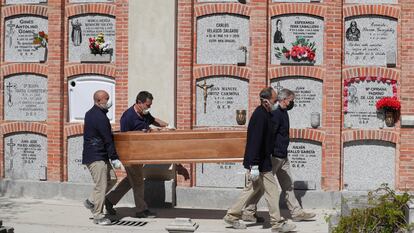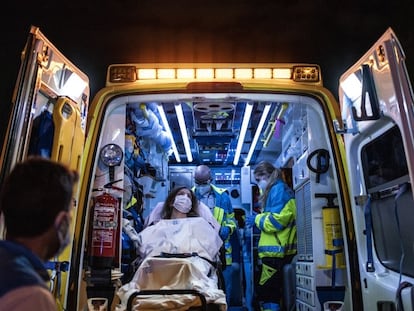The impact of Covid-19 on Spain’s demographics: new highs for deaths, lows for marriage
National Statistics Institute figures for first half of 2020 also show least number of births since 1941


The coronavirus pandemic has had a profound impact on demographic trends in Spain, according to provisional figures for the first half of 2020 released on Tuesday by the National Statistics Institute (INE).
Three records were broken during this period, two of which are tied to the health crisis: a historically high number of deaths, and a record low number of marriages, according to INE data sets going back to 1941.
Experts note that to find another external factor affecting demographic trends in such an exceptional manner, it is necessary to go all the way back to the Spanish Civil War of 1936-39 or even further, to the so-called Spanish flu of 1918.
There were 262,373 deaths between January and June, a 19.6% rise from the same period in 2019. But the most significant figure is the 60.8% drop in weddings, down to 28,327. This could in turn be a sign of an upcoming drop in births, said demographers consulted by this newspaper. Although wedlock is increasingly less of a determining factor in couples’ decision to have children, many couples prefer to formalize their relationship before forming a family.
Birth numbers in the first half of 2020 do not yet reflect the impact of the pandemic, since those children were conceived earlier. But there is still a clear downward trend from the same period in 2019: there were 168,047 births, a 4.2% decline and the lowest number in the series. This figure is expected to drop even further next year.
Meanwhile the rate of natural increase, which measures the difference between births and deaths, also produced a new negative record: deaths surpassed births by 94,326, compared with a difference of 43,921 in the first half of 2019.
“In 2020 the gap between deaths and births accelerated,” explained Albert Esteve, director of the Center for Demographic Studies at Barcelona’s Autonomous University. This expert predicted that when the definitive figures for 2020 are released, the difference between deaths and births “will be close to 200,000 people.”
This would represent “the greatest population loss in decades caused by natural dynamics.” Esteve added that “immigration probably will not make up for this drop.”
Diego Ramiro, director of the Economics, Geography and Demography Institute of the National Research Council (CSIC), feels that it is better to use the 1918 pandemic as a comparison. “Back then the birth rate fell, there was a disruption in marriages, excess mortality multiplied, and there was also an impact on life expectancy that is greater than Covid’s will be, as flu victims died young, between the ages of 15 and 40 to 50.”
The INE said that the rise in deaths over the period was mainly due to the effects of the pandemic from March onwards. Deaths grew across the Spanish territory, with the exception of Murcia and the Balearic Islands.
But experts noted that the figures for the second half of the year are still not in, reflecting the second and third waves of the coronavirus pandemic and their effects on regions that were largely spared by the first wave.
It is still unclear how long the health crisis will last, or what its full impact on demographic trends will be. But the demographer Joaquín Recaño said that the effects could be long-lasting.
“The pandemic is having an important effect on people’s state of mind. It will take us a while to readjust our demographics. If the best-case scenario pans out and we have herd immunity by June, it does not mean that people are automatically going to start having babies, and some economic sectors will continue to be strongly affected, with the impact that this entails,” he said.
In any event, the demographer Albert Esteve predicts more new records in the near future for Spain. “Births will continue to drop in the coming years and deaths will rise, as the baby boom generation ages and passes away,” he said, noting that Spain already has one of the largest shares of population over the age of 65. And unless “there is a lot of immigration as well as a miracle with the birth rate,” the gap between deaths and births will continue to increase and become very significant by 2040.
English version by Susana Urra.
Tu suscripción se está usando en otro dispositivo
¿Quieres añadir otro usuario a tu suscripción?
Si continúas leyendo en este dispositivo, no se podrá leer en el otro.
FlechaTu suscripción se está usando en otro dispositivo y solo puedes acceder a EL PAÍS desde un dispositivo a la vez.
Si quieres compartir tu cuenta, cambia tu suscripción a la modalidad Premium, así podrás añadir otro usuario. Cada uno accederá con su propia cuenta de email, lo que os permitirá personalizar vuestra experiencia en EL PAÍS.
¿Tienes una suscripción de empresa? Accede aquí para contratar más cuentas.
En el caso de no saber quién está usando tu cuenta, te recomendamos cambiar tu contraseña aquí.
Si decides continuar compartiendo tu cuenta, este mensaje se mostrará en tu dispositivo y en el de la otra persona que está usando tu cuenta de forma indefinida, afectando a tu experiencia de lectura. Puedes consultar aquí los términos y condiciones de la suscripción digital.
More information
Últimas noticias
Most viewed
- Sinaloa Cartel war is taking its toll on Los Chapitos
- Oona Chaplin: ‘I told James Cameron that I was living in a treehouse and starting a permaculture project with a friend’
- Reinhard Genzel, Nobel laureate in physics: ‘One-minute videos will never give you the truth’
- Why the price of coffee has skyrocketed: from Brazilian plantations to specialty coffee houses
- Silver prices are going crazy: This is what’s fueling the rally










































